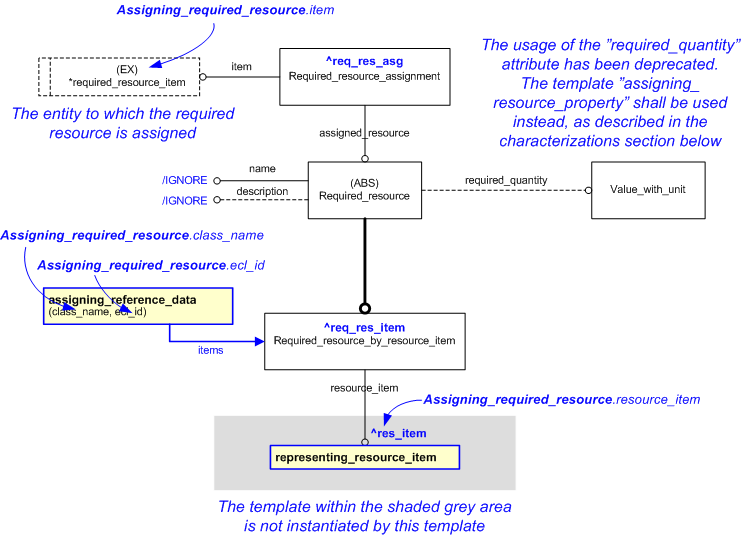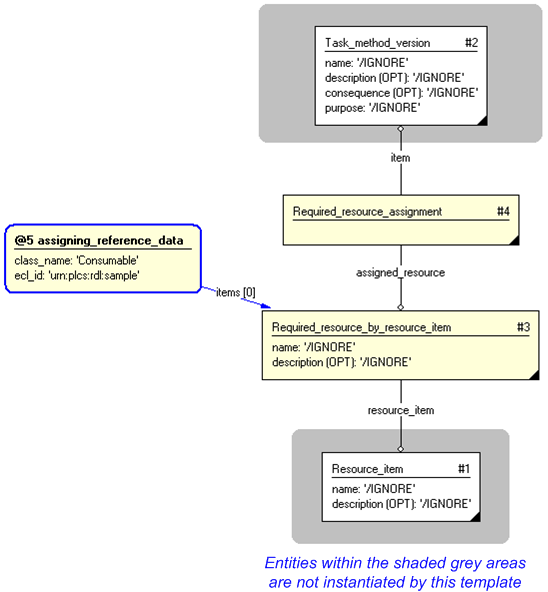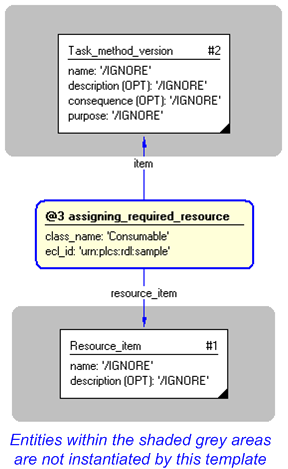Template:— assigning_required_resource (asg_req_res)
Capability:representing_resource |
Date: 2010/09/09 11:24:38
Revision: 1.11
|
This section specifies the template assigning_required_resource.
NOTE
The template has been defined in the context of the capability
representing_resource
which provides an overall description of the
relevant parts of the ISO 10303-239 information model and a description
of related templates.
NOTE
An explanation of a template and the associated instantiation path is
provided in the
Template overview
section.
This template describes how to represent the assignment of a required resource.
The EXPRESS-G diagram in
Figure
1
shows the templates and EXPRESS entities that are required
to represent the template
"assigning_required_resource".
The text highlighted in blue shows the template parameters.
Figure 1 — An EXPRESS-G representation of the Information model for assigning_required_resource
The graphic for the template to be used in other EXPRESS-G diagrams
is shown in Figure
2
below.
Figure 2 — The graphical representation of the assigning_required_resource template
The following input parameters are defined for this template:
The item to which the required resource is assigned.
The resource item that plays the role of a required resource.
The name of the
External_class that determines the role of the required resource given by the
input parameter @resource_item.
The following classes and their sub-classes can be used:
ecl_id (Default=urn:plcs:rdl:std,Type='URN')
The following reference parameters are defined for this template:
%^target = $assigning_required_resource.req_res_item%
%^target = $assigning_required_resource.req_res_asg%
The following parameter combinations specify a uniqueness constraint:
Unique constraint: Unique assignment
There should be one assignment between each assigned resource, item and class in a data set.
Unique constraint: Unique required resource
There should be one required resource item relationship between each assigned resource, item and class in a data set.
The instantiation path shown below specifies the entities that are to be
instantiated by the template.
A description of templates and the syntax for the instantiation path is
provided in the
Templates Help/Information section.
The following entities are instantiated with attributes as specified:
The instance diagram in Figure
3
shows an example of the EXPRESS entities and templates that are instantiated by the template:
/assigning_required_resource(item='#2', resource_item='#1', class_name='Consumable', ecl_id='urn:plcs:rdl:sample')/
(an illustration of the consolidated assigning_required_resource template is shown in
Figure
4 below.)
Figure 3 — Entities instantiated by assigning_required_resource template
The instance model in STEP ASCII exchange file format (ISO 10303 Part
21 syntax) is:
#1 = RESOURCE_ITEM('/IGNORE','/IGNORE',$);
#2 = TASK_METHOD_VERSION('/IGNORE','/IGNORE','/IGNORE','/IGNORE',$,$);
#3 = REQUIRED_RESOURCE_BY_RESOURCE_ITEM('/IGNORE','/IGNORE',$,#1);
#4 = REQUIRED_RESOURCE_ASSIGNMENT(#3,#2);
#6 = CLASSIFICATION_ASSIGNMENT(#8,(#3),'/IGNORE');
#8 = EXTERNAL_CLASS('/NULL','Consumable','/IGNORE',#9);
#9 = EXTERNAL_CLASS_LIBRARY('urn:plcs:rdl:sample',$);
The instance diagram in
Figure
4
shows the graphic symbol for the template that is to be
used in other instance diagrams. The example template is:
/assigning_required_resource(item='#2', resource_item='#1', class_name='Consumable', ecl_id='urn:plcs:rdl:sample')/
Figure 4 — Instantiation of assigning_required_resource template
The following section details how the
assigning_required_resource
template can be optionally characterized by assigning
other constructs to it. These are characterizations commonly
applied to the template. The ISO 10303-239 EXPRESS model may enable
other assignments to the entities instantiated by the template.
The following characterizations may apply:
Characterization Assigning property
NOTE this characterization is optional.




